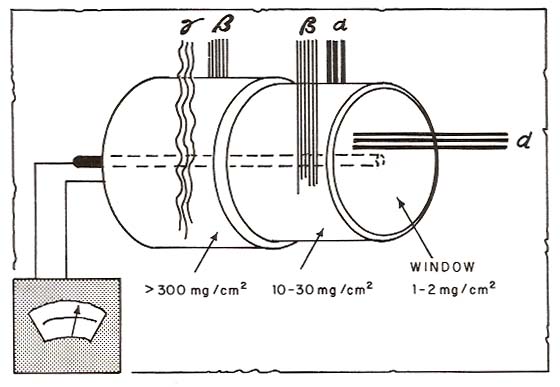
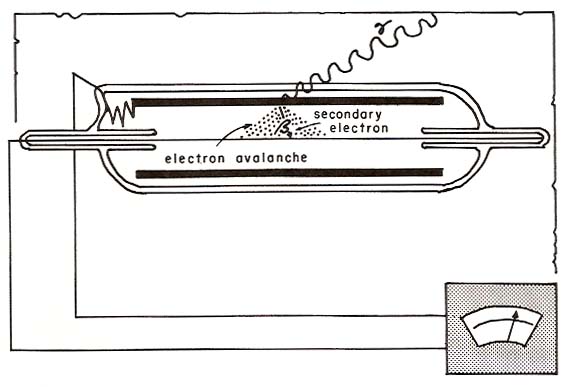
Early Instrumentation - 1920's
Presented in the following section is a description of some of the earliest portable radiation measuring instruments that emerged in the mid to late 1920's and throughout the 1930's. Although there are various reasons for the their development, there was increasing use of x-ray generating devices and radium in the diagnosis and treatment of medical conditions. The instruments originally were developed to provide dose estimates for monitoring and patient treatment. The Geiger Mueller tube was invented in 1928 and is described in the famous papers by H. Geiger and W. Mueller (Geiger, H. and Mueller, W., Phys. Ztschr., 1928, 29, 839; 1929, 30, 523). These tubes were known as ionization chambers or spark gaps. When a voltage is applied across the electrodes to the point of near breakdown, only a slight perturbation, such as an incoming gamma ray can cause a discharge and the resulting signal. As such a small amount of radiation can result in a energetic signal which can be measured with electronic circuitry.
The following is an referenced except on Hans Geiger.
"In the early 20th century, many scientists were looking for ways to
measure radiation, which had been discovered near the end of the previous
century. Radioactivity is the spontaneous emission of radiation (waves or
subatomic particles) exhibited by certain elements due to either the unstable
nuclei of its atoms or a nuclear reaction. To investigate radioactivity
adequately, researchers needed to detect and quantify radiation. There was,
however, one problem: Radiation cannot be detected by the unaided human senses.
Enter Hans Geiger, a young German scientist on the staff at the University of
Manchester. Having received his Ph.D. from the University of Erlangen in 1906,
he moved to England and began studying radioactive emissions with up-and-coming
nuclear physicist Ernest Rutherford, chair of the physics department. Rutherford
had an ardent interest in special particles, called “alpha particles,” that are
emitted from radioactive materials (alpha particles are nuclei of helium-4
atoms). Knowing that alpha particles can travel through very thin solids,
Rutherford and Geiger developed a method of detecting the particles using gold
foil and a screen: After passing through the foil, the particles hit the screen,
producing on impact barely detectable flashes of light. The scientists (Geiger
especially) spent innumerable hours counting these flashes in a dark room. As
Rutherford recounted in a 1908 letter to a friend, “Geiger is a good man and
work[s] like a slave.... [He] is a demon at the work and could count at
intervals for a whole night without disturbing his equanimity.”
In 1908, hoping to reduce the time, strain and imprecision involved in the work,
Geiger built a device that automatically counted individual particles. This
early form of what became known as the Geiger counter detected only alpha
particles. A later version developed in the late 1920s by Geiger and his student
Walther Müller was sensitive to all types of ionizing radiation.
The Geiger counter typically consists of a cylinder (called a Geiger tube)
capped with a thin material such as mica through which radiation can penetrate.
The cylinder is filled with inert gas and connected to a voltage source. Down
the middle of the cylinder runs a wire or needle that functions as a positive
electrode; the cylinder wall is a negative electrode. When a particle of
radiation penetrates the cap of the tube, it knocks a charged particle off a gas
atom inside, thus ionizing it. This displaced particle then heads, depending on
its charge, either toward the positively charged wire or the negatively charged
cylinder wall. This sets in motion an ionizing avalanche: More and more
particles get knocked off gas atoms as the first one rushes toward the electrode
attracting it. This flurry of particles creates an electrical pulse when it hits
the electrode, which is then amplified so it can be observed, usually as a
clicking sound. The number of clicks generated per second by a Geiger counter
indicates the intensity of the radiation it is measuring.
Using the Geiger counter, Geiger and Rutherford performed many groundbreaking
experiments involving alpha rays and alpha particles. Upon the outbreak of World
War I, however, Geiger returned to his motherland to serve in the armed forces.
After the war, he taught at a number of German universities and continued
perfecting his radiation detector. Its final form is generally known as the
Geiger-Müller counter in recognition of Müller’s contribution. Other scientists
also made modifications to the design. One of the most notable adaptations makes
the device capable of detecting neutrons and other non-ionizing radiation.
With the much faster and more sensitive detection device he built with Müller,
Geiger made several important scientific contributions. In 1925, he used the
counter to experimentally verify the Compton effect, which is the scattering of
X-rays and their decrease in energy upon interaction with matter. A few years
later, he used several Geiger counters at once to observe showers of cosmic
rays, a phenomenon which became the focus of his research."
The following section contains some of the earliest portable radiation detection instruments.


Schematics of an ionization chamber (left) and a Geiger counter (right)
In 1925, R. Kegerreis developed a portable apparatus for measuring x-rays. Its design and construction "involves many complicated laws of physics of x-rays and electricity". Different filter for absorption can be added depending on the x-ray tube being measured. It is contained in an aluminum cabinet about the size of any ordinary suitcase. When opened the ionization chamber can be removed via a 15 foot armored cable. The unit weighs 40 lbs. and uses several 22.5 volt batteries which contribute to most of the weight.
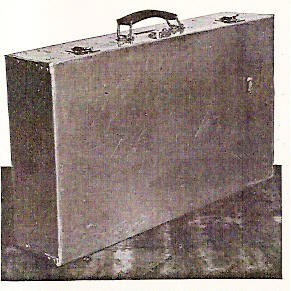
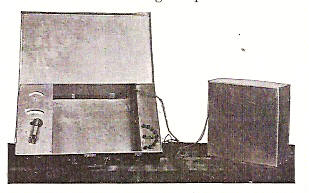
Kegerreis Portable Apparatus closed (left) and open (right) 1925
Around this same period, there was also the commercial Solomon’s Ionometer, designed by Iser Solomon, a French radiologist. It was also at this time in 1928, that Geiger and Mueller published an announcement of the developed of a device for measuring radiation.
Victoreen is credited with building several condenser-type ionization chamber instruments in 1927 which were stored in the laboratory due to lack of need. The chamber was 1 cm3 consisting of a carbon wall and aluminum electrode. The charge was applied with a friction wheel. Glasser and Seitz made an experimental condenser-type ionization chamber with a removable chamber that could be separated from the electrometer. Glasser turned to Jack Victoreen in 1928 to market the first commercial instrument know as the Condenser R-Meter. It was an ionization meter connected to an electrometer. These units would later become the precursor to the first commercial U.S. ionization chambers developed by Victoreen in 1930.
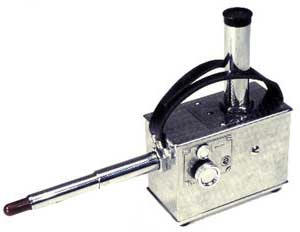
Victoreen Condenser R-Meter 1928
The first units were friction charged with a battery powered light for the meter. The unit was later know as the Victoreen R-meter.
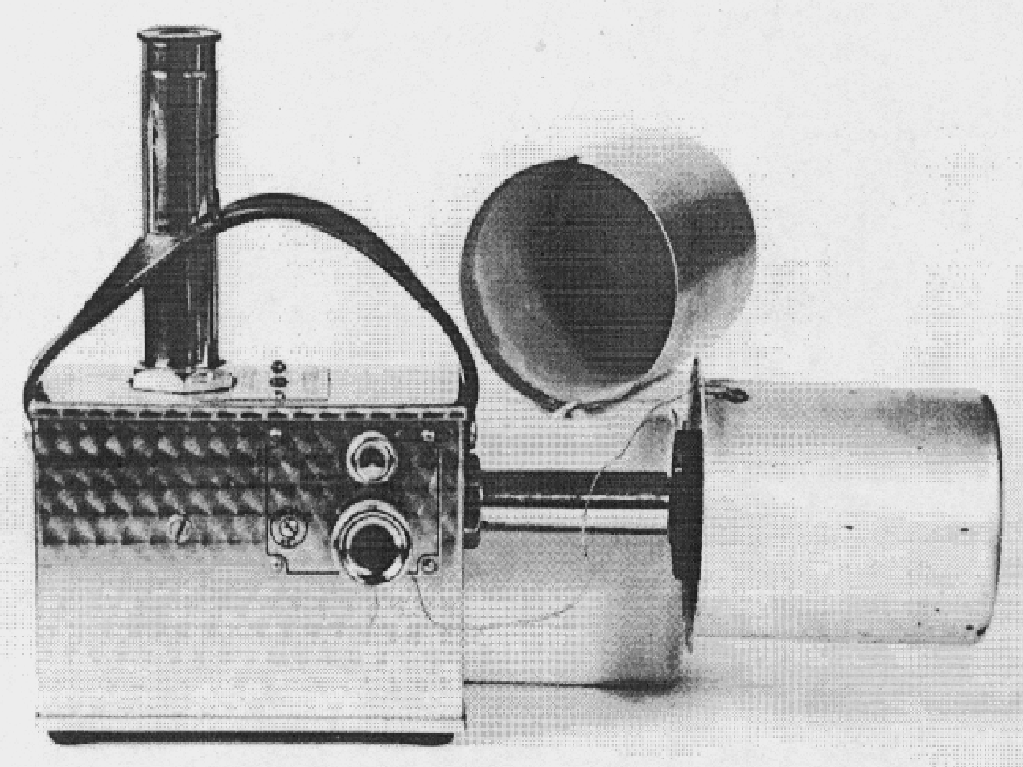
Victoreen R-Meter 1935
In 1929, Lauriston Taylor at the National Bureau of Standards developed the first portable survey meter incorporating interchangeable chambers for various radiation exposure rate ranges. The lead-lined Lauriston electroscope is a medium-sized, portable survey instrument for x-rays. It was developed to conduct international comparisons of x-ray standards. It has an ion chamber that is charged and then discharges proportional to the amount of radiation measured. It was 8” x 3” x 14” and weighed 8 lbs.
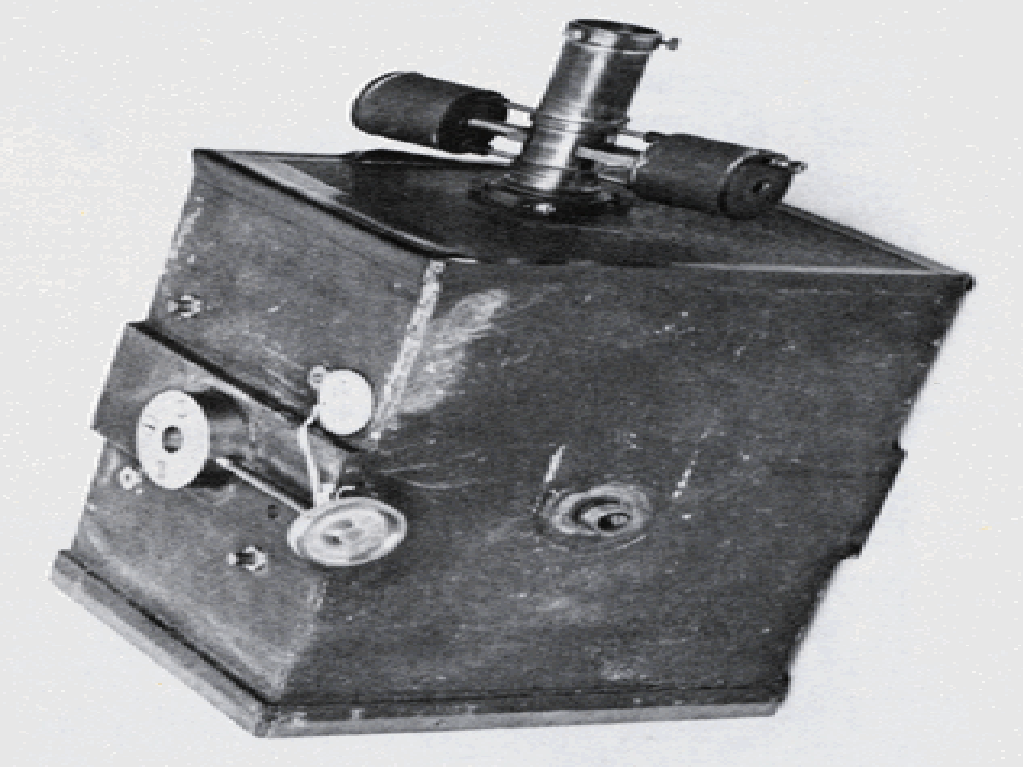
Lauriston Taylor Meter 1931
In 1933, Dr. Curtiss, also of the National Bureau of Standards, developed a portable ionization chamber detector for locating lost radium. The unit had an external probe with an ionization chamber measuring 2.5” diameter x 8” long. The unit weighed 18 lbs and was battery operated. The unit was referred to as the “Curtiss Radium Detector”. It was easy to use for untrained personnel. The unit had a shoulder strap for carrying and a long extension probe for checking around hospital containers and cracks in floors. The unit was reportedly sensitive to 25 mg of radium at 7.5 feet or 10 mg at 3 feet. Ash cans, barrels or cabinets can be examined without emptying them.
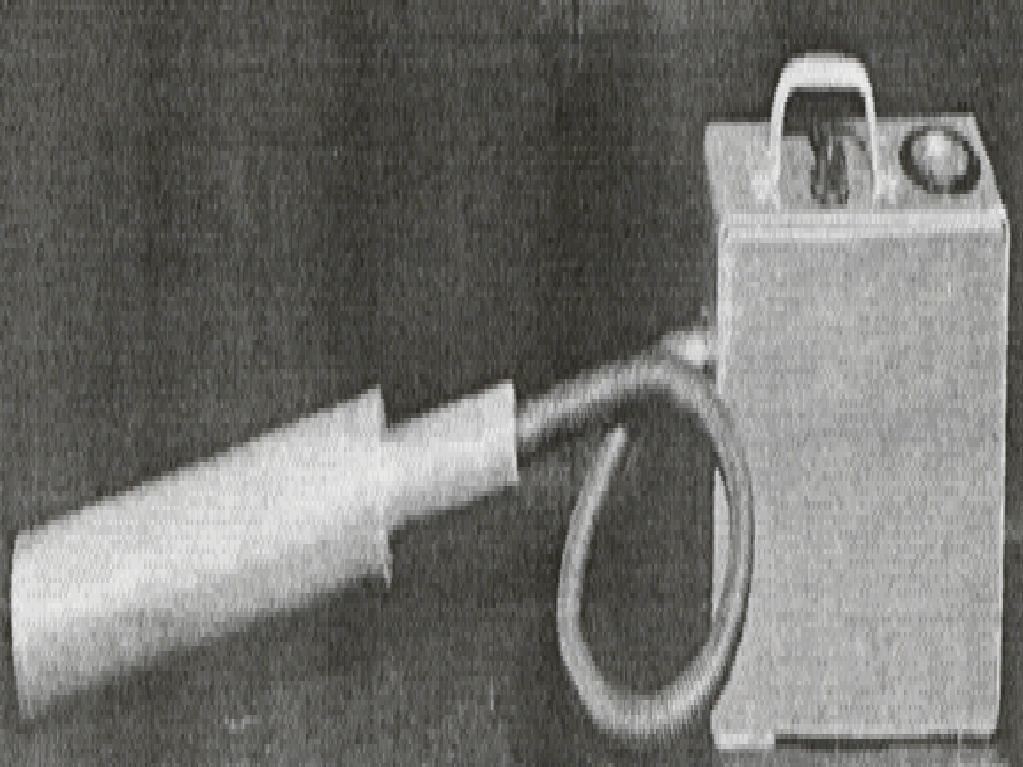
Curtiss Radium Detector 1933
The Curtiss Radium Detector was marketed in 1934 by the American Instrument Company (AMINCO) of Washington, D.C. as the Radium Detector under catalog No. 2100-01 and sold for $180. It was so easy to use, that one can operate it without practice. Searches that required days by the old electroscope method may be performed in less than an hour with the Curtiss detector.

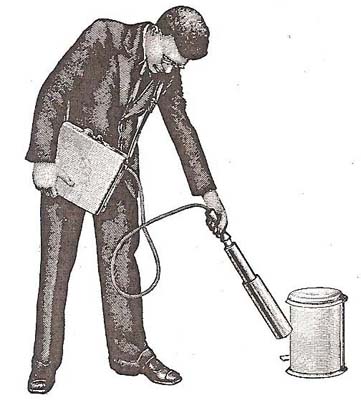
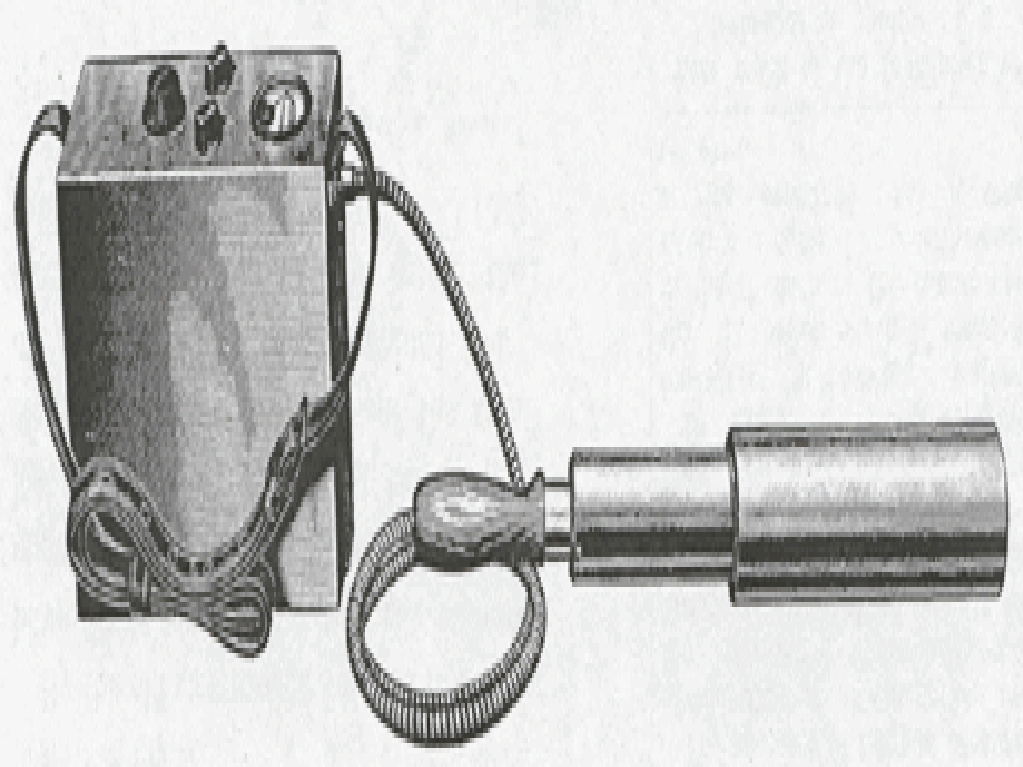
American Instrument Company Radium Detector 1934
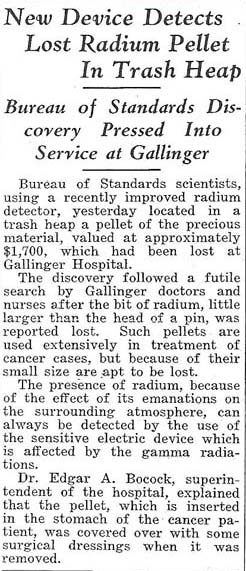
New Device Detects Lost Radium Pellet in Trash Heap using the Curtiss Detector 1930's
In one case a pig swallowed a radium needle. It took a gold-leaf electroscope to find it.
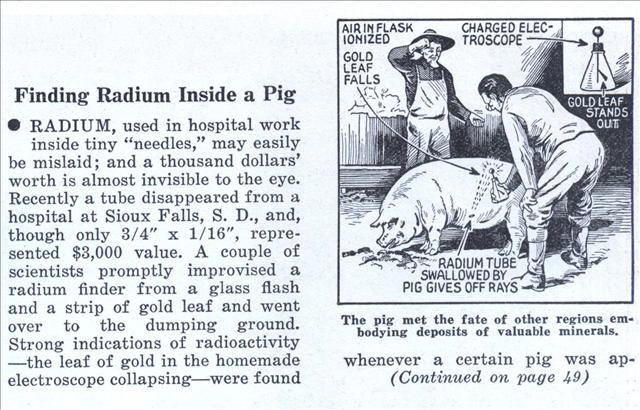
Early story on locating a radium needle in a pig
Radium tubes and needles were routinely moved around in hospitals pre-1950 and undoubtedly lost or misplaced. Using the radioactivity, it was possible to locate the radium as long as you could detect the radiation. The loss of material was an emergency both for safety and value. The following is a quote about the Radium Hen - "Radium hen" also known as the "Clucking Hen" a GM detector with audio output developed by Thomas Chalmers at the National Physical Laboratory in England in 1934. The name derived from the audio output which sounded like clucking. Quoting an August 24, 1935 article in the Reno Evening Gazette: "The hen family can well be proud of the "bird". It is sexless and yet clucks excitedly like any barnyard Leghorn. It needs no food, except electricity, looks like an ordinary watering can, and has led perplexed scientists to the location of many radium eggs." The Radium Hen would get my vote as the first true survey meter. The unit has a neon "Osglim" lamp that will arc over due to ionizing radiation at the right electrode potential. The interrupted circuit results in a "cluck cluck" sound in the earphones. The potential is adjusted to give just a few clucks per minute caused by the natural radioactivity. The lamp is located in a tin can at the end of the probe. The probe is attached to an attaché case via a cable. As such the probe can be used to search in tight spots such as incinerators and other places where radium can be lost in discarded medical dressing.
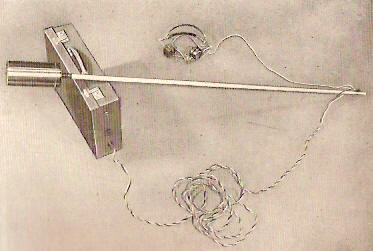
Radium Hen Geiger Muller Counter 1934
Dr. Taft began working with radium in 1933. Radium is used in very small quantities for the treatment of medical diseases. The quantities were typically about the size of a quarter inch of pencil lead. These radium sources could cost as much as $12,000 each in 1938. Dr. Taft employed an early homemade electroscope for his routine exposure measurements when working with the radium. A colleague requested that Dr. Taft assist him in locating a lost 75 mg radium source. He used his electroscope and then after locating the source began improvements to his instrument. His instrument became known as the “Radium Hound”.
Dr. Taft worked with charging devices for electroscopes and various derivations as early as 1926. He responded to a request for locating a lost radium source in a doctor’s office. He used his electroscope and then after locating the source began improvements to his instrument. Radium is used in very small quantities for the treatment of medical diseases. The quantities were typically about the size of a quarter inch of pencil lead. These radium sources could cost as much as $12,000 each in 1938. His instrument became known as the “Radium Hound”. In 1944, Dr Taft was Professor of Radiology at the Medical College of Charleston.
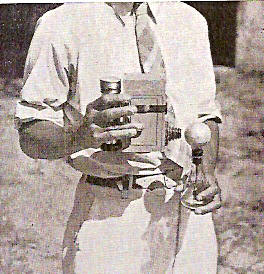
Small Electroscope used for early radium searches 1933
The instrument consisted of a simple gold leaf electroscope with a charging device. The electroscope is mounted in a small glass flask about 4 inches high. The gold leaf is 1” x ¼” with a 2” cork fishing float coated with aluminum paint. It was determined that 1/13,000 R will produce a noticeable movement in the gold leaf.
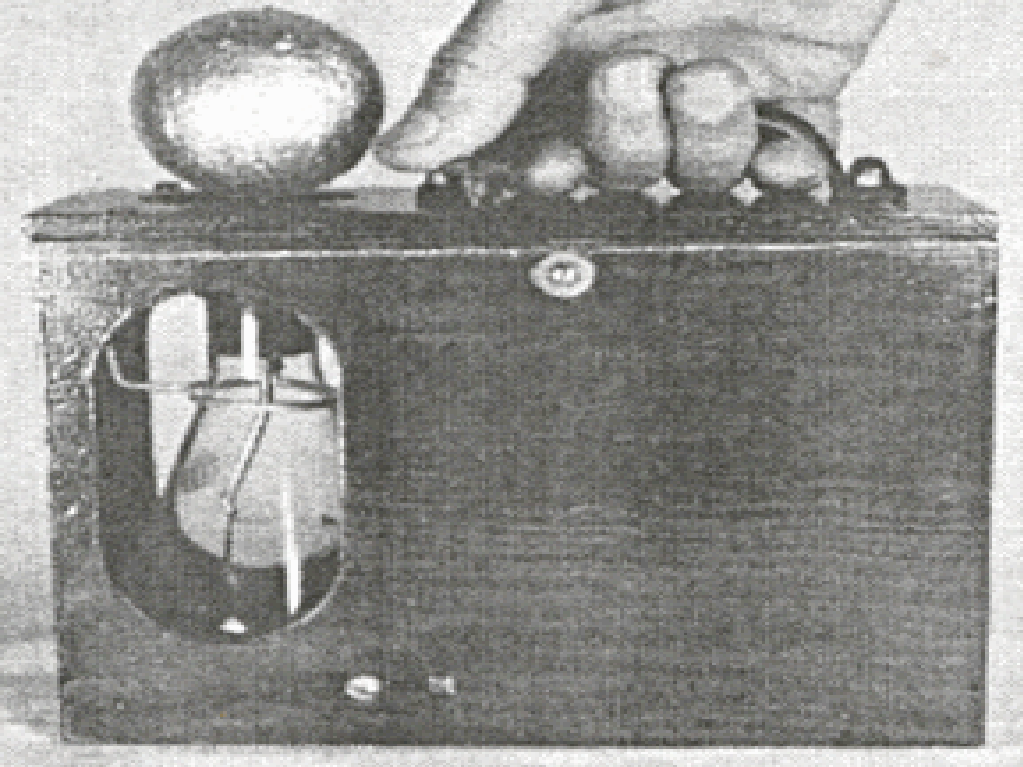
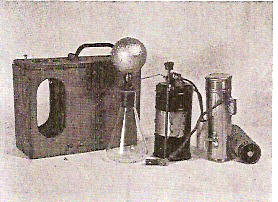
Simple Radium Detector 1934
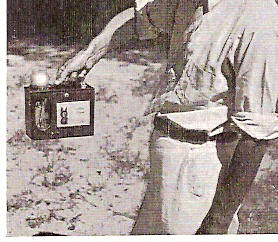
Taft Radium Detector 1937
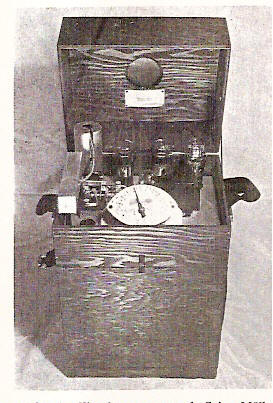
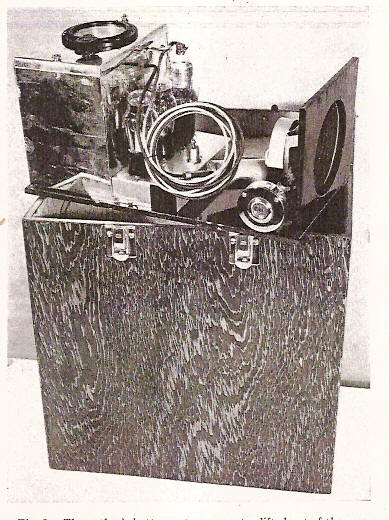
Taft GM Battery Powered Unit 1938
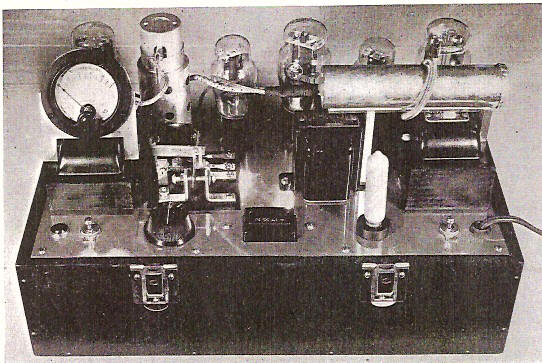
Taft GM Locher Tube 1938
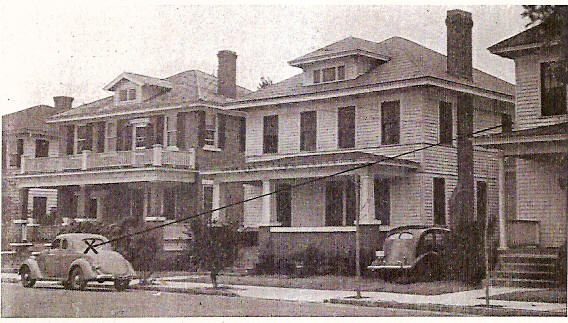
Taft GM Counter with Locher Tube for Building Search from Car 1938
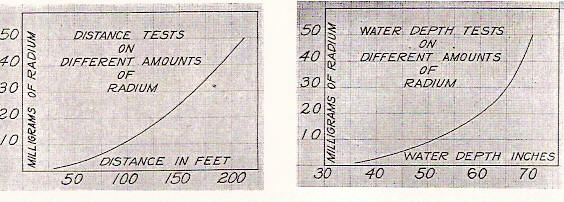
Taft Distance Measurements using Radium in Air and Water 1938
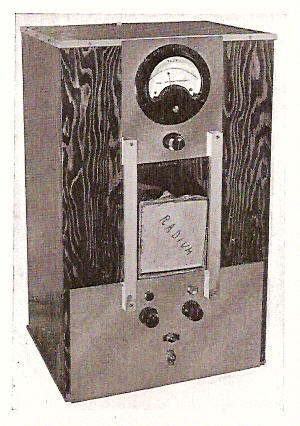
Taft Radium Quantity Meter 1939
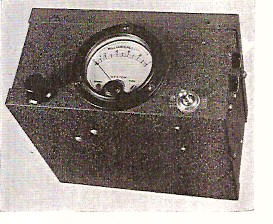
Taft Portable GM Counter 1942
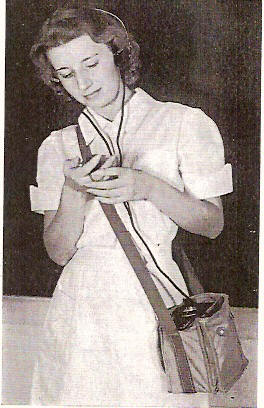
Taft Portable GM Counter with Operator 1942
Dr. Locher of the Bartol Research Foundation developed a GM counter for locating radium and for measuring x-ray intensities. The unit consisted of a portable control unit with the GM tube at the end of a 3 foot cable. The operator listening to the clicks using headphones. The unit's amplifier and recording equipment was made by Herbach and Rademan. The unit provides 900 volts from a 90 volt dry battery and a ten-to-one DC "voltage multiplier". This new approach allowed for much lighter weight of the control unit.
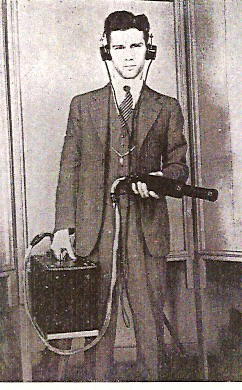
Locher Demonstrated Herbach and Rademan GM Counter 1936
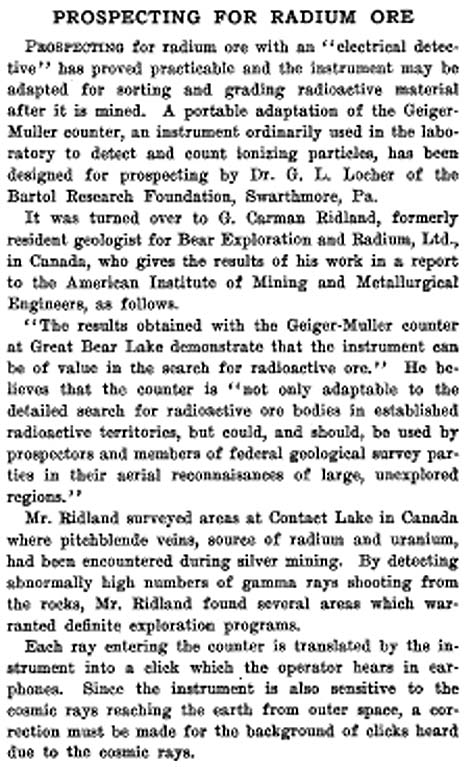
Locher News Article on Hunting Uranium 1943
A sensitive portable detector was developed by J. E. Morgan in 1936. Although the unit was portable, it was connected to AC power via an extension cord. It had lead shielding on three sides to give it a directional feature for isolating radium needles. It was designed specifically for recovering lost radium needles in the hospital setting. Other uses were found including measuring radioactive chemicals such as thorium dioxide and hydroxide within the body of patients undergoing diagnostic treatment. By placing the instrument next to the patient, it is possible to determine which organs are accumulating the radioactive chemical and the rate of excretion.
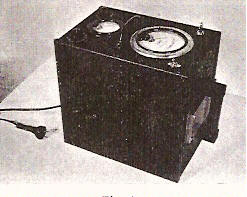
Morgan Portable Detector 1936
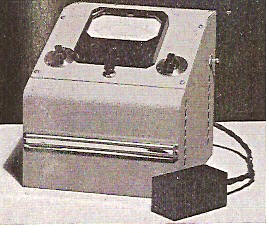
Morgan Exposure Meter 1942
In 1937, Walter Bosch presented information on a student type portable GM counter for cosmic rays and natural radioactivity. The unit was compact and portable and weighed 52 lbs. It was enclosed in a wooden box measuring 13” x 16” x 11” with front and back panels made of masonite. It used 20 batteries weighing 27 lbs. and giving 900 volts. It use a Locher type tube.
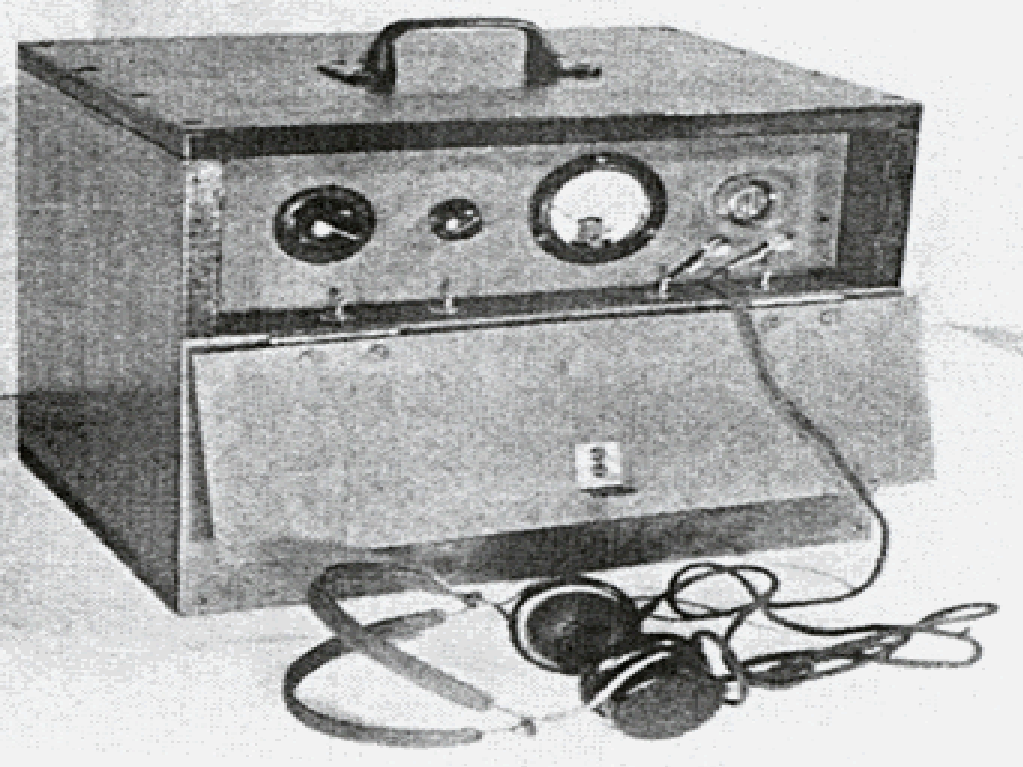
Student Type Portable GM Counter 1937
In 1937, C.B. Braestrup developed a GM to locate the weak signals that may be encountered with lost radium. He used a glass GM tube with low pressure argon gas and operated at 800 volts. The GM tube schematic is shown below.
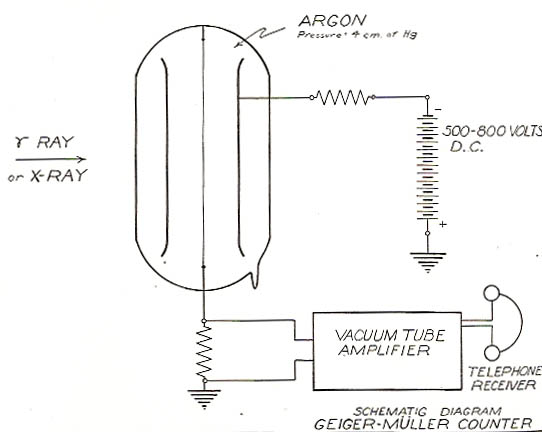
Schematic of Braestrup GM Counter 1937
Two types of GM tubes were used. One had the GM tube in a separate unit which was tethered by a short cable. The cable had to remain short since all of the power and electronics were in the main control box. In a later version, the GM tube with associated electronics and power were all contained in the smaller unit and as such the cable could be 25 feet allowing more flexibility. He employed the unit as a "Radium Finder" and employed its directional effect. He did this by placing the GM tube in a 12 cm long lead cylinder which was 2 cm thick. It could easily detect 1 mg radium at 15 feet. He has used the Radium Finder to locate lost radium which was found in a drain pipe and in the ash of incinerators. In additional to being valuable material, these quantities of radium can also cause harm if it was next to the skin. In one particular case, one of the lab technicians lab coat was found to be contaminated from a leaking radon tube.
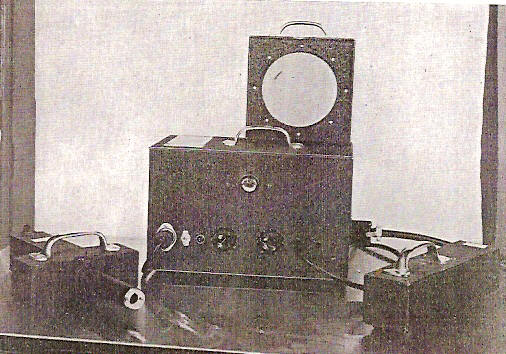
Braestrup GM Counters (left and right of control unit) 1937
In 1937, M. L. Weinstein reported on an apparatus for gamma radiation detection. It can be used for detecting harmful gamma rays from x-ray and radium equipment. It can also be used for located lost radium and has been referred to as the Electric Detective or the Radium Hen. Two units were developed, one which operated on 110 volt AC and on that was battery powered. The batteries were contained in the lower part of the enclosure.
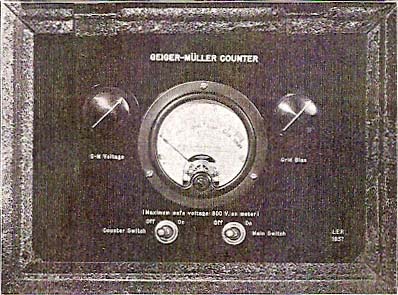
Weinstein GM Counter with AC Power 1938
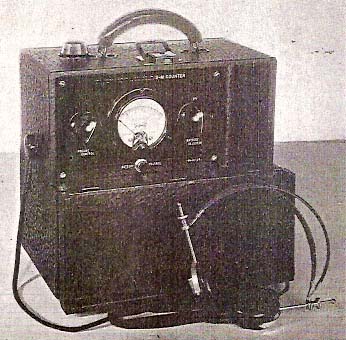
Weinstein GM Counter with Battery Power 1938
The portable instrument can be used to locate lost radium. It gives twice the natural background count of 10 impulses per minute and 20 impulses per minute for 1 mg radium at 30 feet with no shielding. The unit can be carried by a handle on top and the operator can listen to the clicks with the accompanying headphones.
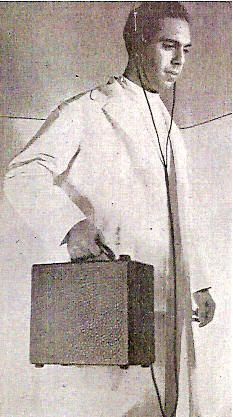
Weinstein GM Counter in Use 1937
The unit can also be used to study radium poisoning for toxicology studies and for tagged atoms for physiology studies.
In 1938, Curtiss produced a Portable Geiger Counter Unit. It contained a neon lamp flasher as an indicator. This unit had a low voltage Geiger counter operating at 450-650 volts as opposed to earlier units operating at 1200 volts. The Geiger counter was 5 to 6 cm in diameter with a gas mixture of hydrogen and argon at 6 to 7 cm pressure. It also contained a Cenco counter attached at the end of the unit for readout. The Geiger counter is mounted in the lightweight cylinder on on the top of the unit under the handle.
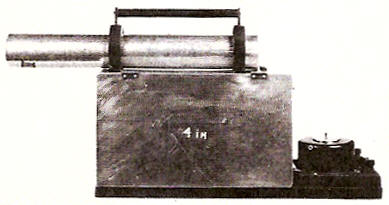
Curtiss Portable Geiger Counter Unit 1938
The Philips Metalix was developed in 1942.
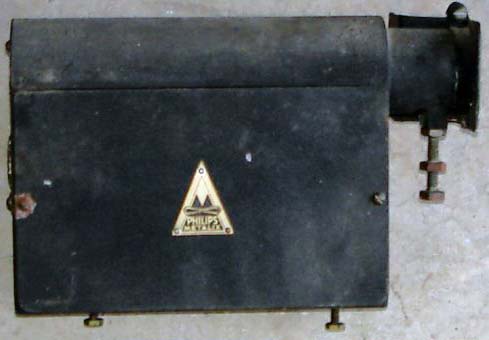
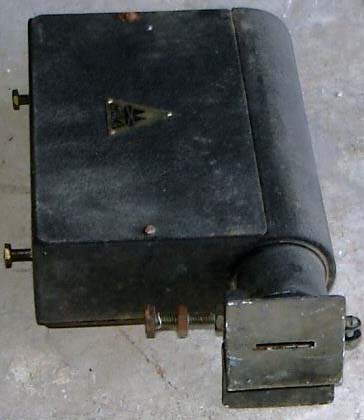
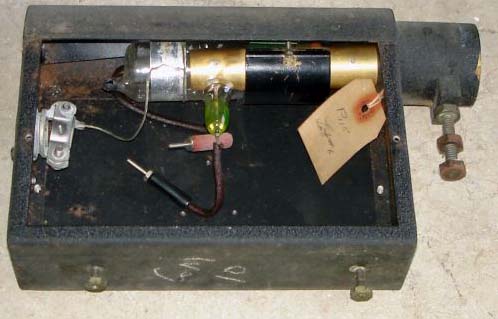
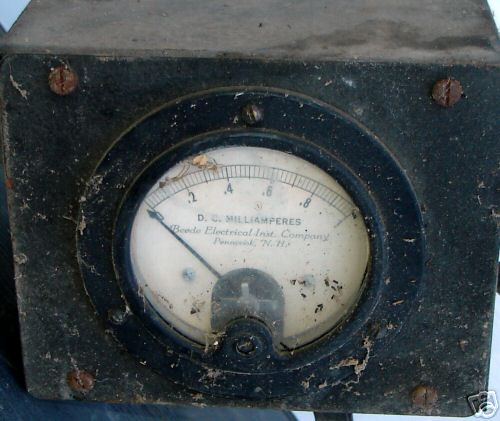
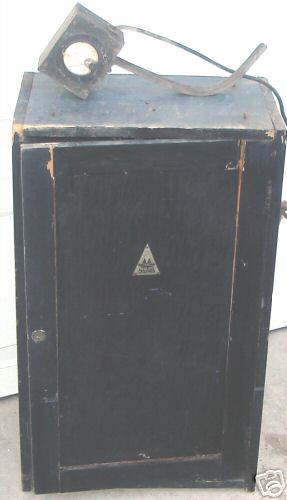
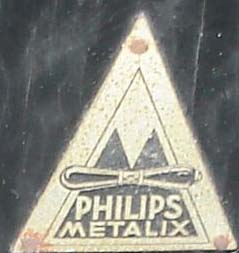
Philips Metalix 1942
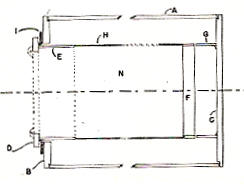
Simpson Counter 1944
E.A. Hamacher developed the Portable High Sensitivity Ionization Meter at the Massachusetts Institute of Technology in 1941. It was used to measure the radioactivity from an operating cyclotron. The ionization chamber consists of a bored 4" diameter aluminum chamber. The unit dimensions were 12 x 7 x 6 inches.
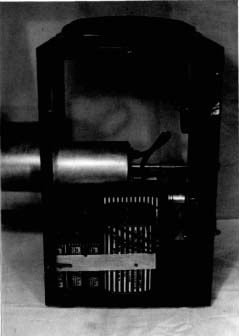
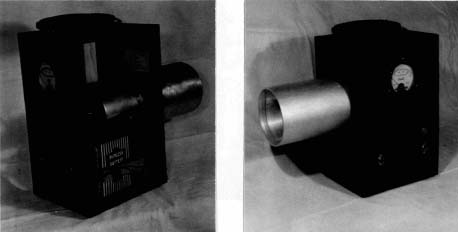
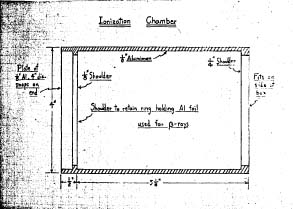
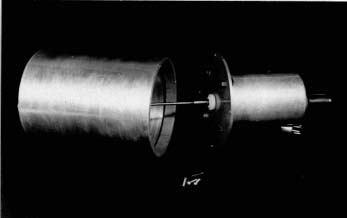
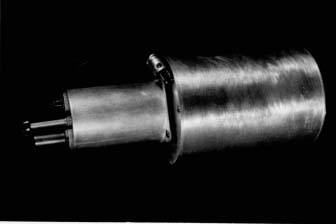
Hamacher Detector from MIT 1941
The Portable Direct-Reading X-Ray Intensity Meter by R. K. Bulllington (University of New Mexico) in 1937 consists of an ionization chamber made from 3/4 inch ebonite cylinder with a volume of 10 cc. The walls were 1/16 inch thick and painted on the inside with aquadag (colloidal graphite) to make it conducting. The electrode is an aluminum wire along the axis. The unit operated at 100 volts obtained from three 45 volt batteries.

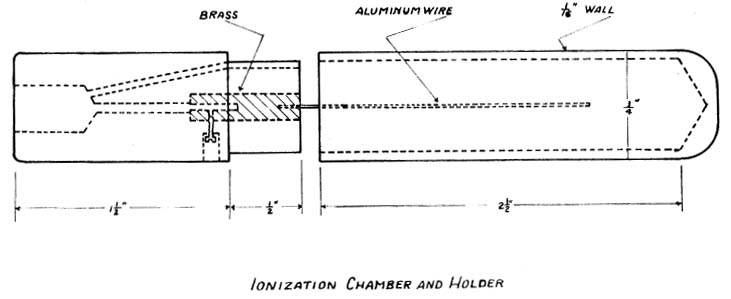
Bullington Direct-Reading X-ray Intensity Meter 1937